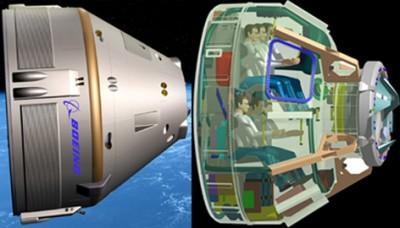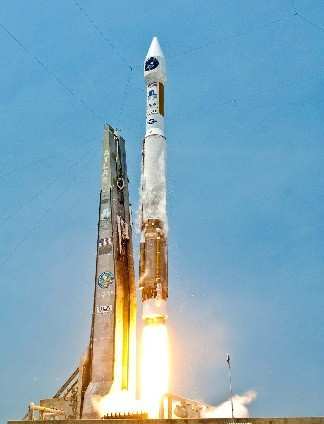Sat, Sep 15, 2012
Integrated Systems Review Proposes CST-100 Spacecraft Boosted By An Atlas V Launch Vehicle
The Boeing Company has completed its first performance milestone for NASA's Commercial Crew Integrated Capability (CCiCap) initiative, which is intended to lead to the availability of human spaceflight transportation services for government and commercial customers. In its Integrated Systems Review (ISR), Boeing presented the latest designs of its CST-100 spacecraft, United Launch Alliance's Atlas V rocket launch system, and ground and mission operations. These designs will serve as the baseline for further development work to be accomplished during CCiCap. The company also discussed its plans for safety and mission assurance, which ultimately will contribute to achieving certification of the system for human spaceflight.

"The ISR established a firm baseline configuration that will allow our team to push forward with the final vehicle design", said John Mulholland, Boeing vice president and program manager for Commercial Programs. "We hope the rigor of our design and development process, and our outstanding team of suppliers will help position the CST-100 as one of the next crew transportation vehicles to the space station and other low Earth orbit destinations."
Technical experts from NASA's Commercial Crew Program (CCP) participated in the review in Houston. They are in the process of providing comments and advice based on more than 50 years of human spaceflight experience.

"All of our industry partners are gearing up to push their human spaceflight technologies further than ever before so America can have its own crew transportation system around the middle of the decade," said Ed Mango, CCP's program manager. "This review was just the first of many exciting and valuable milestones Boeing is expected to complete during its funded partnership with NASA."
At the review, Boeing also presented results from numerous tests that were conducted as part of its earlier Commercial Crew Development Round Two Space Act Agreement with NASA. These tests included parachute and air bag drops, abort engine firings and wind tunnel tests. NASA's new CCiCap agreements follow two previous commercial endeavors by the agency to spur the development of crew transportation systems and subsystems. Work by NASA's industry partners during CCiCap will set the stage for a crewed orbital demonstration mission around the middle of the decade.
Future development and certification initiatives eventually will lead to the availability of human spaceflight services for NASA to send its astronauts to the International Space Station. The overall goal of NASA's commercial space efforts is to make low Earth orbit more accessible and open for business for other government and commercial customers.
(Images Top Boeing CST-100, Bottom ULA Atlas V launch)
More News
Improvements Stack as Brand Readies for Mass Production Samson Sky updated followers on its flying car progress, describing some of the travails of the wind tunnel as they get clos>[...]
LAHSO An acronym for “Land and Hold Short Operation.” These operations include landing and holding short of an intersecting runway, a taxiway, a predetermined point, or>[...]
Dave Juwel's Aviation Marketing Stories ITBOA BNITBOB ... what does that mean? It's not gibberish, it's a lengthy acronym for "In The Business Of Aviation ... But Not In The Busine>[...]
Aero Linx: Space Medicine Association (SMA) The Space Medicine Branch was founded in 1951 as the first constituent organization of the Aerospace Medical Association (AsMA). In 2006>[...]
Back-Taxi A term used by air traffic controllers to taxi an aircraft on the runway opposite to the traffic flow. The aircraft may be instructed to back-taxi to the beginning of the>[...]
 Samson Sky Hits the Wind Tunnel
Samson Sky Hits the Wind Tunnel ANN's Daily Aero-Term (05.22.24): LAHSO
ANN's Daily Aero-Term (05.22.24): LAHSO Aero-FAQ: Dave Juwel's Aviation Marketing Stories -- ITBOA BNITBOB
Aero-FAQ: Dave Juwel's Aviation Marketing Stories -- ITBOA BNITBOB ANN's Daily Aero-Linx (05.19.24)
ANN's Daily Aero-Linx (05.19.24) ANN's Daily Aero-Term (05.19.24): Back-Taxi
ANN's Daily Aero-Term (05.19.24): Back-Taxi




